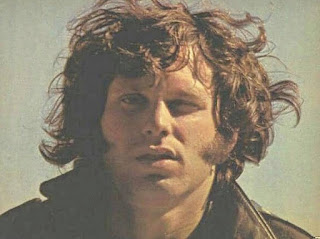The Doors' very first compilation 13, originally released in 1970, turns 50 this year! To celebrate this milestone, 13 will be available for the first time in 37 years on August 7th! This 50th Anniversary edition features remastered audio by The Doors' longtime engineer/mixer Bruce Botnick, pressed on "Ink Spot" blue and white swirl vinyl and housed in a meticulously reproduced version of the original artwork including record labels and the printed inner sleeve.
Laurel Canyon is a very real place, but it comes off almost as a Brigadoon-style dream in the commemoration of the L.A. rock scene of the late ’60s and early ’70s that is director Alison Ellwood’s “Laurel Canyon” (2020) The first half the two-part docuseries on Epix, which premiered May 31, threw a spotlight onto the Byrds, the Doors, Buffalo Springfield, Mamas and the Papas, Love, Frank Zappa and others who drove the counterculture in the years leading up to Woodstock, and how they were folksy neighbors in L.A.’s least urban enclave. Ellwood does use a fair amount of audio from deceased subjects like Jim Morrison, Ray Manzarek, Cass Ellliot, Arthur Lee and Bryan MacLean, so putting everyone in voiceover puts everyone back on the same mortal coil for cinematic purposes.
-Variety: You’d been wanting to do a film about this for 20 years, since you became fascinated with the Doors, so you were immersed in a lot of the lore. Were there any stories that you hadn’t heard before?
-Alison Ellwood: I didn’t know about the Doors/Love connection, in which the latter band helped the Doors get a record deal with Elektra, only to come to regret it. I had no idea that Alice Cooper met Jim Morrison or how he was tied to the Canyon at all. That came as a total surprise. Source: variety.com
Patricia Butler: Rainer Moddemann fled the scene when I tipped off Danny Sugerman what Rainer was posting in his page, and Danny went there and kicked Rainer's sorry ass, letting everyone know in no uncertain terms that Rainer was a liar and a thief and that the Doors planned to sue him up one side and down the other for the things he's done. As for the notion that anything in my book came from Rainer, this was not only never "rumored," but to anyone who knows anything about Rainer and his actions over the years, it's nothing short of ludicrous. Rainer had his shot with the Doors, and actually could have made something of that opportunity if he hadn't decided instead to lie (he was telling everyone that he was "the Doors European representative", which he wasn't, by any stretch of the imagination) and steal (he actually stole gold records out of Robby Krieger's home and stole photos from Danny Sugerman) and stab them in the back. Not surprisingly, Rainer is a big friend of Patricia Kennealy, and would do anything to stay in her good graces, including making up a lot of nonsense about Pamela Courson. How pathetic is it to make up things to denigrate a dead woman? By the way, while Pamela had many faults, she was neither a heroin addict nor a hooker, no matter how hard Kennealy and her friends work to make people believe otherwise.
Oh, and just another bit of info -- Rainer Moddemann didn't know Jim Morrison, or Pam either, even though he likes to try to convince people otherwise. My favorite story about Rainer is when he wrote a letter, in fact, to Jerry Hopkins, trying to convince Jerry he shouldn't deal with me. What Rainer didn't know, of course, was that Jerry and I were very close friends. So Rainer sends Jerry this letter full of all kinds of dire sounding lies (the best part was when he told Jerry he'd seen me drunk in Paris when Jerry knows I don't drink). Jerry sent me a copy of the letter he sent back to Rainer. It was quite entertaining, to say the least!
Patricia Kennealy: Contrary to the picture painted in the Doors mythology, Pamela Courson was no poster girl for the 60's spirited, enlightened independent feminist. Very much the opposite: she was a shallow, manipulative, junkie trollop. But she was so pretty. She really was. By her own life and death, Pamela Susan Courson furnished an incontestable proof: if she had had any guts or brains whatsoever, she would still be here, alive and crying, but alive and thriving. As I am.
Veteran rock journalist Barney Hoskyns indicated in his 2001 book, "Arthur Lee: Alone Again" the brief friendship between Arthur Lee and Jim Morrison. Hoskyns has quite a resume, having written for Rolling Stone, Harper's Bazaar, Spin, The Independent, and he also was Chief Editor at MOJO Magazine. In "Arthur Lee: Alone Again," Hoskyns states that Jerry Hopkins co-managed Love in 1965, and later Hopkins became a rock writer for Rolling Stone magazine. Jerry Hopkins would co-write with Danny Sugerman "No One Here Gets Out Alive." NOHGOA is one of the worst organized books I've ever read. It doesn't have an usable table of contents and there's no index at all. I found it odd that Hopkins didn't mention in No One Here Gets Out Alive that he'd managed the rock group Love. Hopkins described how Arthur Lee had helped The Doors get a contract with Elektra, but he failed to mention that he managed Lee's band, Love. Why? Maybe an old beef or some kind of resentment? Jim Morrison stated in 1967 that his favorite vocal groups were "the Beach Boys, the Kinks, and Love."
Arthur Lee encouraged Elektra Records’ founder and president, Jac Holzman, to sign the Doors. Barney Hoskyns asserts that Jerry Hopkins and Doug Lyon co-managed Love in 1965. Ronnie Haran, a talent scout/publicist for the Whiskey A-Go-Go began calling record companies, inviting representatives to come see what she called "the American Rolling Stones." A few actually came to check them out. The Beach Boys’ producer Nick Venet didn’t like them at all. Lou Adler was unmoved. The Rolling Stones weren’t impressed either. Nor was Jac Holzman, the thirty-six-year-old music producer and president of Elektra Records. Holzman was urged to see the Doors once more by Ronnie Haran, but also by Arthur Lee, the leader of Love. “Jim Morrison was an intellectual genius in the sense that he was well read – Voltaire, Camus, and all that stuff,” noted Ronnie Haran. “Arthur never read any of those books, but he was a street-smart genius. He was a natural perceiver of where people are coming from.” So Holzman returned and decided there was something appealing in Jim Morrison. By the fourth visit he found himself making his pitch, offering the Doors a contract. Jac wanted they understood that Elektra was a small business company whose tidy and tight-knitted organization was accessible. Arthur Lee had met Pamela Courson when she was living in his Laurel Canyon neighborhood. She was living in a dark Canyon garage reconverted into a house. She barely scraped by. Until they made it, then it wasn't unusual for garages to be rented out to the local musicians--they were cheap digs. Arthur Lee sort of took Pamela under his wing, and they dated for a short while. They had a love relationship that ended in friendship. Jim Morrison found Pam shortly after she had broken up with Arthur Lee. Source: love.torbenskott.dk
Arthur Lee: When I lived in Laurel Canyon, I used to walk from Brier to the Country Store on Laurel Canyon Boulevard. On my way down the hill, I liked seeing all the colorful people at the scene with their beautiful clothes. By then, it was fashionable to rent garages in the area as places to stay. I was coming up Kirkwood Drive one day and I noticed a girl dancing on the other side of the street. She had her garage door pulled up and I could examine her fixed-up garage home. She was a very nice-looking young lady, with shoulder-length red hair, freckles, and a cute figure. I don’t remember who made the first move, but both of us started talking. As I looked around her place, I noticed something was missing. I don’t remember if there was a refrigerator or not but I didn’t see any food around. When I asked if she would like me to buy her some groceries, she smiled and said “yes, thanks, my name is Pam.” And so it became a routine; as I walked or drove up Kirkwood, I would stop by her place and drop off some food and drinks for Pam.
I told her about my group Love, and I asked her if she would like to come up to my place and trip with acid. She said she would, and that was my first date with Pamela Courson. She told me she was from Orange County and she was a go-go dancer in The Strip clubs. Our relationship was good until I saw her flirting with other guys. So it sort of played out after a while, but we remained friendly. She was a good kid, but too flirtatious for my taste. Later, I would see Jim Morrison in Laurel Canyon from time to time, and now Pam was living with him. I found Jim Morrison to be a very interesting guy, although the girls seemed to appreciate him a lot more than I did. After a while, with Ray Manzarek playing the organ in the band, I could see that The Doors were doing something quite different. I told Jac Holzman to go down and check them out at The London Fog. So it was then that The Doors became the second West Coast group signed to Elektra Records.
It wasn’t that I didn’t like Jim Morrison. I just didn’t really know him as a friend. I had enough friends hanging around me at that time. One time, I was at the Tropicana Hotel, on Santa Monica, and out of my window I saw Jim and Bryan MacLean standing, face to face. All of a sudden, Jim socked Bryan in the mouth, pretty hard. Bryan made the mistake of mentioning Pamela or something else. I actually thought that was the best thing I’d ever seen Jim Morrison do. Bryan said that they were arguing and Jim hit him square in the mouth. I said to myself, “Regardless of what I think, Jim Morrison’s got a heart.” Bryan could really get on your nerves and it didn’t come off too good with Jim. After that, I lost sight of him. I think Jim Morrison was a very lonely person. He was always searching for something. Now that I think about it and put it all together, it seemed like he didn’t have a real self. He only lived on what he was told it was happening. He portrayed something that he thought was great but I don’t think he got a chance to be his true, natural self – or perhaps he didn’t like his natural self. He tried to become someone else. And it caught up with him. You finally catch up with yourself, you look in the mirror and you have to face yourself. —"Arthur Lee: Alone Again" (2001) by Barney Hoskyns




















































